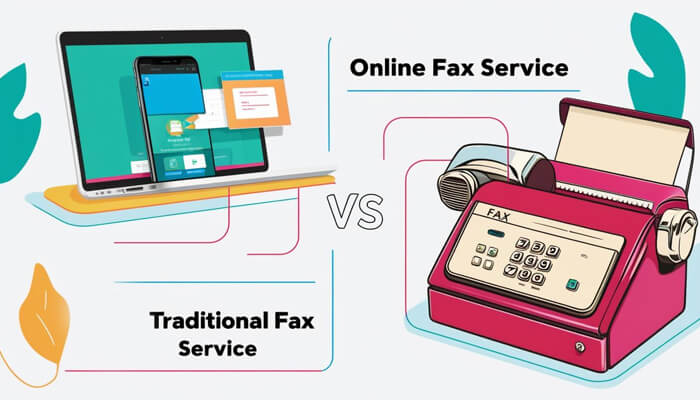Explanation of Traditional Faxing and Its Limitations
Traditional faxing technology has served as a fundamental method of document transmission since its inception, utilizing telephone lines to convey information efficiently. However, as businesses have evolved and adopted digital solutions, Online Fax Service has emerged as a more efficient alternative. This method overcomes the limitations of traditional faxing, improving both efficiency and security.
Challenges such as elevated costs, the necessity for physical paper and supplies, and cumbersome maintenance have rendered traditional faxing less favourable in today’s technology-driven environment. Furthermore, the lack of integration with modern document management systems restricts its effectiveness in optimizing workflows, particularly for organizations requiring remote access and real-time updates.
Additionally, traditional faxing poses significant security risks, as sensitive data is often transmitted over unsecured lines, increasing the likelihood of interception. This vulnerability can result in compliance issues, particularly for industries that manage confidential information.
In contrast, online fax services provide encrypted transmissions and robust authentication measures, substantially enhancing document security. The inefficiencies associated with waiting for a fax to be received or troubleshooting paper jams starkly contrast with the immediacy and convenience of digital alternatives.
By adopting online faxing, businesses can manage documents seamlessly while ensuring that adequate protections are in place against potential breaches.
Benefits of Using an Online Fax Service
The adoption of an online fax service The Advantages Of Using Online Fax Services For Businesses offers a variety of advantages over traditional fax methods, rendering it a progressively favored option for businesses seeking to improve their document management processes.
These services deliver cost-effective solutions, enabling companies to send and receive faxes without the associated expenses of paper, ink, and the maintenance of fax machines.
The convenience of accessing fax functionalities from any location, combined with scalability options and user-friendly interfaces, greatly enhances overall workflow efficiency while addressing the increasing demand for remote work and mobile access.
Cost Savings and Convenience
One of the most compelling reasons to transition to an online fax service is the substantial cost savings it provides in comparison to traditional faxing methods. By eliminating the necessity for physical fax machines, supplies, and extensive maintenance, organizations can benefit from a more economical subscription plan that aligns with their document transmission requirements.
The convenience of sending and receiving faxes through a user-friendly web application or cloud-based platform streamlines the entire faxing process, rendering it both efficient and hassle-free.
This transition not only reduces operational costs but also minimizes the resources allocated to managing obsolete hardware. Online fax services offer flexible subscription models that accommodate varying usage levels, allowing organizations to select a plan that aligns with their faxing frequency without incurring unnecessary expenses.
The integration of these services into existing workflows enhances productivity, enabling employees to transmit documents within seconds and circumventing the prolonged wait times typically associated with traditional methods. The overall efficiency gained from adopting online faxing can lead to significant improvements in both time and cost savings, ultimately benefiting the organization’s financial performance.
Increased Security and Reliability
In today’s landscape, where data breaches and cyber threats are increasingly prevalent, the enhanced security features of online fax services represent a significant advantage. Unlike traditional fax machines, which can render sensitive documents vulnerable to unauthorized access, online faxing solutions employ advanced encryption protocols to ensure the secure transmission of documents.
This dedication to security not only promotes compliance with industry regulations but also fosters trust among clients and stakeholders, thereby enhancing the overall reliability of business communication.
Many of these services comply with rigorous industry standards, such as HIPAA for healthcare and GDPR for European data protection, ensuring that sensitive information is managed appropriately.
By implementing multi-factor authentication and maintaining secure server environments, online fax services provide an additional layer of protection that substantially reduces the risk of data leaks.
This comprehensive strategy for safeguarding information not only addresses the demands of regulatory compliance but also plays a critical role in establishing a reliable communication channel. As organizations prioritize the protection of their confidential data, they can confidently depend on these fax solutions to mitigate potential vulnerabilities.
How to Choose the Right Online Fax Service
Choosing the appropriate online fax service is essential for facilitating seamless document transmission and improving overall business efficiency. Several factors must be considered, including the reliability of the service, the user interface, and the range of features provided by each vendor.
Services like Fax.Plus offer reliable and secure faxing solutions that can meet the needs of businesses looking for efficient and scalable faxing options.
By evaluating leading providers based on criteria such as cost, security measures, international faxing capabilities, and customer support, organizations can make well-informed decisions that align with their specific requirements and compliance standards.
Factors to Consider and Comparison of Top Providers
When selecting an online fax service, it is essential to consider several critical factors to ensure that the chosen provider effectively meets your requirements. Key aspects to evaluate include service reliability, which is vital for uninterrupted document transmission, and the availability of customer support to assist with any technical issues that may arise.
Comparing the features offered by top providers—such as fax scheduling, integration capabilities with email, and mobile access—can yield significant insights into which service will enhance workflow automation and productivity.
Additionally, it is important to assess pricing structures, as some services offer subscription models while others may charge on a per-page basis. For example, if frequent faxing is necessary, a provider that offers unlimited plans may be more economical in the long run.
Security considerations are also paramount, particularly when transmitting sensitive documents. Features such as encryption and compliance with regulations like HIPAA can be crucial in safeguarding confidential information.
Prominent options such as HelloFax, eFax, and MyFax each present unique benefits tailored to various business needs, ensuring that organizations can identify the most suitable solution in today’s digital landscape.
Tips for Using an Online Fax Service Effectively
To fully leverage the advantages of an online fax service, it is imperative to adopt best practices that enhance the overall efficiency of the faxing process.
A comprehensive understanding of the range of available faxing features—such as document tracking, automated faxing, and the capability to send and receive faxes online—can markedly improve your document management strategy.
Additionally, being cognizant of common user errors can help avert pitfalls that may impede productivity and disrupt workflow automation.
Best Practices and Common Mistakes to Avoid
Implementing best practices when utilizing an online fax service can significantly enhance the efficiency and security of document transmission. It is essential to familiarize oneself with the user interface, manage user accounts effectively, and leverage features such as fax delivery tracking and document history to ensure a seamless faxing experience.
In contrast, common errors—such as failing to verify fax limits or misunderstanding compliance requirements—can result in costly mistakes that undermine the efficiency of the faxing process.
To maximize these benefits, it is imperative for users to regularly review and update their faxing settings, ensuring alignment with the most current business requirements. Dedicating time to train staff on the various functionalities of the service can prevent errors and improve overall workflow.
Additionally, users should be vigilant not to overlook security features; neglecting to utilize encryption when transmitting sensitive information may expose them to potential data breaches.
Ultimately, proactive management of online fax operations will not only enhance productivity but also safeguard the integrity of important documents.



